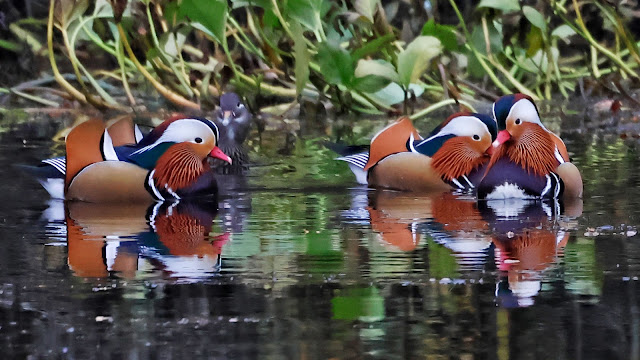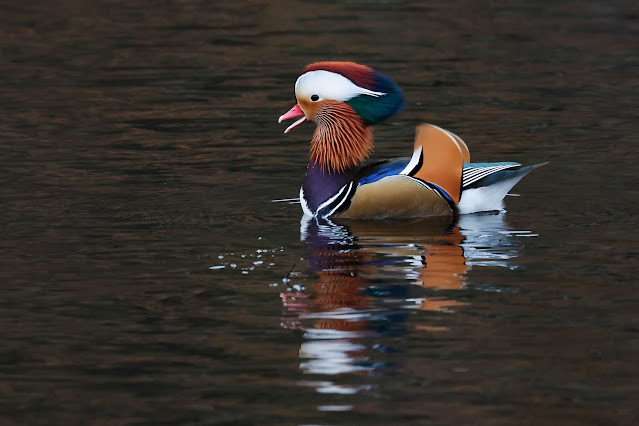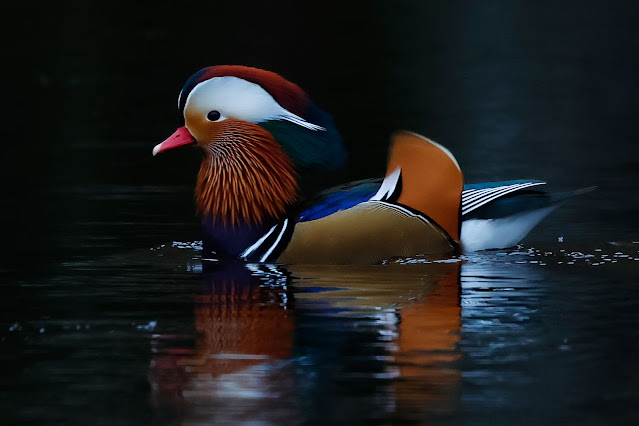I decided today I need to look for Brambling in the New Forest, so initially set off for Cadman's Pond, where Brambling have been reported, but along the way decided to detour to Eyeworth Pond. Normally every year Ian and I would check in here for the Mandarin Duck, but as we saw one early in the year at Blashford we didn't see the need. However nothing beats a drake Mandarin Duck in full breeding plumage and Eyeworth also is able to deliver dark water that sets off the spectacular plumage.
As I arrived there were Mallard by the shore, but no sign of the Mandarin. I changed and walked along the path and found them on the far side of the pond under the low hanging trees. With a little encouragement two drakes appeared.
Initially they stayed at the back of the pond but gradually started to swim over to me.
A colourful gathering of three males.
Then they moved into the dark water.
Then the drakes started to display.
The beautiful mandarin duck was introduced from the Far
East, where it can still be found in China, Japan, Korea and parts of Russia.
It escaped, or was deliberately released, from captivity in the UK. Mandarin
ducks are actually quite shy birds, often hiding beneath overhanging willows
and usually only forming small flocks.
More wing flaps.
A beautiful, unmistakable duck: male mandarins have
elaborate plumage with orange plumes on their cheeks, orange 'sails' on their
back, and pale orange sides; females are dull in comparison, with grey heads,
brown backs and white eyestripe.
The mandarin duck nests in holes in trees, sometimes high up and a long way from the water. Shortly after the ducklings hatch, the female flies down and tries to coax the young to jump from the nest. Once they have left the tree and made their way back to water, the father will return to the family and help to protect the ducklings.
The dark water really enhances the colourful plumage.
Leaving the Mandarins I made my way to my original destination, Cadman's Pond. There are plenty of Beech and Oak trees around the pond and it looks like there has been some feeding of the birds. I walked around the area adjacent to the car park but was only able to find Chaffinch, Blue and Great Tits in the beech mast. Walking around the pond there were Redwing and Fieldfare in good numbers and for once it was possible to get some good views of the Fieldfare.
The sandy soil around the pond is good for Fly Agaric, the classic Toadstool, in the autumn, I was a bit late for them and many were destroyed or gone over, but I did manage to find this one.
As I searched for the Fly Agaric I flushed out a small flock of more Mandarins. Brown water here doesn't look so spectacular.
From Cadman's Pond I headed for Blashford Lakes. Once there I made my way to the Ivy Lake South Hide, where there was a good chance of Kingfisher. I brought my lunch and was determined to settle in an wait.
A drake Tufted Duck showed very well in front of the hide, always a nice duck to photograph.
A stare from a Tufted Duck!
A pair of Kingfishers flew past the hide and completely ignored the posts! That was to be the only sighting in the two hours I was there. In front were Gadwall, Shoveler and Wigeon feeding on the big clump of weed. Although one Wigeon was quite happy to snooze.
I gave up on the Kingfishers after two hours and decided to try the hides on Ibsley Water. First was the Goosander Hide and there was absolutely nothing to be seen. I could see the gulls gathering in the middle of the lake so decided to head for the Tern Hide.
Aside from the gulls it wasn't much better in the Tern Hide. Pochard to the left, plenty of Tufted Duck, a few Goosander, one Goldeneye and two distant Great Egret was all, so it was down to the gull roost and I did manage to find at least three Adult Yellow-legged Gulls, which saved the visit.
Adult Yellow-legged Gulls in winter lacks the Herring Gull’s
heavy streaking on the head and neck, instead showing only limited light grey
streaking on the crown and maybe the nape.
From December / January this streaking difference becomes less clear as
they both start to acquire their white summer head colour. Adult Yellow-legged tend to start moult
earlier and this makes them stand out as a sleek smart white headed gull.
The Yellow-legged Gull has only recently been recognised as
a species in its own right, having previously been considered to be a race of
Herring Gull. Adults have darker grey backs and wings than Herring Gull
but are paler than the Lesser Black-backed Gull. They have more black in the
wing tips than Herring Gull and smaller white 'mirrors'. The legs as the
name suggests are bright yellow.
With it becoming quite gloomy I decided to head home just after 15:00. Some lovely Mandarin phots early on and a year tick in the Yellow-legged Gull, so not a bad day.








































No comments:
Post a Comment